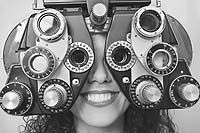As the old saying goes, “seeing is believing.” In the case of glaucoma, perhaps the adage should be adjusted to say “seeing and feeling is believing.” Though nearly 3 million Americans suffer from glaucoma, the Glaucoma Research Foundation reports that half of those cases go unreported. Since most people with glaucoma still see and feel fine, they believe they have no vision problems.
Glaucoma does not necessarily cause noticeable symptoms, at least not ones most people would assume are not just a part of aging. But that does not mean it’s not doing damage, as glaucoma is the leading cause of blindness in the United States, accounting for between 9 and 12 percent of all blindness cases throughout the country. Because there are few or no symptoms to indicate the presence of glaucoma, regular eye exams bring on even greater importance. In addition, knowing what glaucoma is and how it can affect everyday life can lend a greater sense of awareness about this potentially damaging disease.
There are two types of glaucoma, each of which involves fluid and pressure buildup on the eye.
•Open Angle (or Wide Angle) Glaucoma: The more common type of glaucoma, open angle glaucoma occurs when fluid cannot exit the eye through the trabecular meshwork, or the drain of the eye. Essentially, the eye’s drainage canals become blocked, increasing inner eye pressure as fluid cannot drain. When a person has open angle glaucoma, these drainage canals are similar to a clogged sink. While the drain in the sink itself is not clogged, the pipe going underneath the sink is. Similarly, the openings to the drainage canals are fine, but are clogged further in.
•Angle Closure Glaucoma: Angle closure glaucoma occurs when the angle between the iris and the cornea (where a drainage channel for the eye is located) is too narrow, resulting in poor drainage. This type of glaucoma is far less common than open angle glaucoma, and often results in sudden pressure build-up in the eye.
Glaucoma can occur in young adults, children and even infants, though it’s most common in adults over the age of 40. African-Americans are more likely to get glaucoma and often do so at a younger age and with more severe symptoms, such as a greater loss of vision than other victims.
Those who are also at a greater risk of glaucoma are:
•People with a family history of glaucoma
•People with poor vision
•Diabetics
•People taking any systemic corticosteroid medication, such as prednisone.
In most instances, there are not noticeable symptoms, a frightening thought when considering vision lost to glaucoma cannot be recouped. However, any of the following symptoms should set off an alarm and result in an immediate visit to an eye specialist.
•Loss of peripheral, or side, vision, which is often a telltale sign of the onset of glaucoma
•Seeing halos around lights
•Persistent redness in the eyes
•Pain in the eye
•Eyes that look hazy, even after periods of prolonged rest
•Onset of tunnel vision, wherein a person’s vision becomes increasingly narrow
Glaucoma cannot be prevented. The best thing anyone can do, whether they’re in the more susceptible demographics or not, is to get regular eye exams. If detected early, glaucoma can be treated, greatly reducing potential vision loss. Treatment options include eye drops, laser surgery or microsurgery. An eye specialist will suggest what’s the best option depending on each individual case.
What people with glaucoma can expect is continued vision loss if they don’t seek treatment. Eventually, without treatment, blindness will occur. However, very few people who have glaucoma end up going blind, as the aforementioned treatment options will prevent further vision loss.
To learn more about glaucoma, visit the Glaucoma Research Foundation Web site at www.glaucoma.org.
Regular eye exams are important to detection and treatment of glaucoma

unknown
